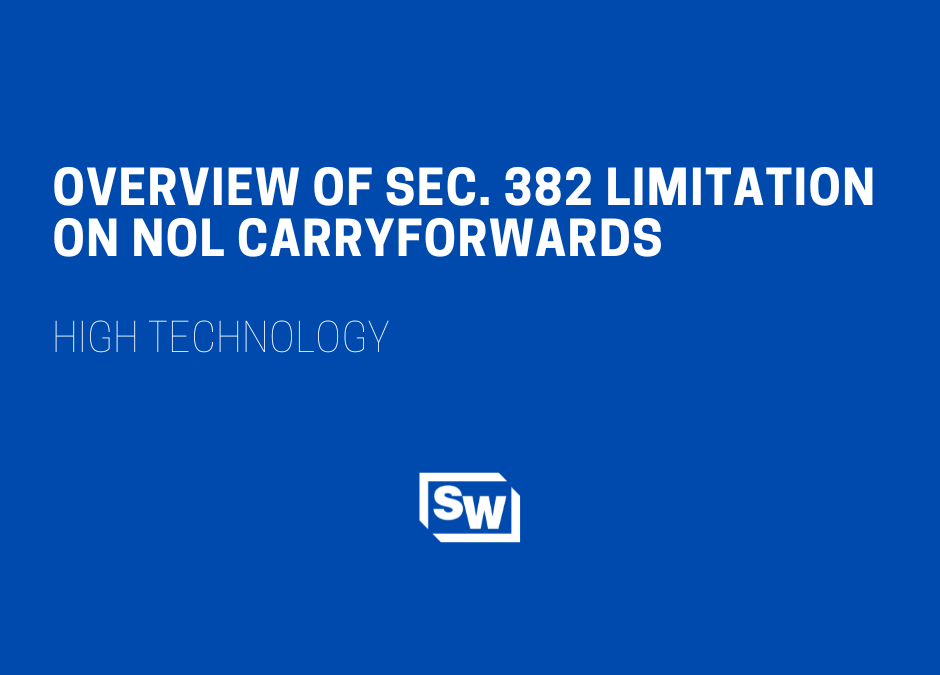Section 382 of the Tax Code is applicable to a loss corporation, defined as a corporation that has accumulated net operating losses. Many start-up companies in high-tech industries incur substantial research and development expenses and remain unprofitable for multiple years. The provisions of Sec. 382 are relevant to these companies and might constrain the deductibility of accumulated net operating losses against future taxable income. Performing these calculations annually is crucial as Sec. 382 mandates related disclosures in the annual income tax return. This article offers an overview of the key concepts employed in these calculations.
Sec. 382 imposes a restriction on the utilization of net operating losses (NOLs) and specified built-in losses after a change in ownership. An ownership change occurs if, within a testing period, the ownership of 5 percent shareholders has increased by over 50 percentage points from the lowest percentage of stock owned by these shareholders during the testing period. Shareholders owning 5 percent are defined as those who possess 5% or more of the corporation’s stock. Ownership is assessed based on the fair market value of the stock, not the quantity of shares held. Other essential terms to understand include:
- Testing date: a date on which there is a change in the relative stock ownership of one or more 5 percent shareholders.
- Testing period: a three-year span concluding on the testing date or the period from the last ownership change through the testing date, whichever is shorter.
- Public group: a collective treatment of groups of shareholders with less than 5 percent ownership, treated as a single 5 percent shareholder.
On each testing date, the corporation must conduct calculations to ascertain whether a change of ownership exceeding 50% has occurred. The results of these calculations should be disclosed in the corporation’s annual tax return. The disclosures should include the following: testing dates during the year, confirmation of whether a change of ownership exceeding 50% occurred and on which date, and the total accumulated net operating losses. In the event of an ownership change, the company should consider whether to elect to close the books on the date of the change. If the election is not made, income and loss will be allocated to periods before and after the change on a per-day basis.
Sec. 382 calculations are highly intricate, and multiple rules and exceptions apply. Examples of some of the more commonly applicable provisions are:
- Constructive ownership rules: When determining 5 percent shareholders, constructive ownership rules must be employed. If relatives own shares, their ownership might need to be aggregated. If an individual owns shares directly and through a pass-through entity or another corporation, these shares might also need to be combined. Accurate identification of all 5 percent shareholders is the foundation for subsequent calculations.
- Segregation rules: Certain corporate transactions, like stock issuances, are treated as segregation transactions, creating new public groups that the loss corporation must separately track as new 5 percent shareholders. There are exceptions to these segregation rules, such as cash issuance or small issuance exceptions. Utilizing these exceptions is often advantageous for the company and should not be overlooked.
- Definition of stock: Sec. 382 includes rules for determining what constitutes stock. Convertible debt, stock options, stock warrants, SAFEs, or other financial instruments may or may not be included in the calculations, depending on their terms and specific circumstances surrounding their issuance.
Once it is established that the change in ownership exceeds 50%, the annual limitation is calculated as follows:
- Value of the Corporation × Federal Long-Term Tax-Exempt Interest Rate
- Value of the Corporation: The fair market value of the corporation’s stock immediately prior to the change in ownership.
- Long-Term Tax-Exempt Interest Rate: The highest among the adjusted federal long-term rates applicable in any month within the three months preceding the ownership change.
Illustrative Example:
Loss Corporation, Inc. had $1 million of NOL carryforwards on 7/1/23, the date when more than 50% ownership change occurred. The corporation’s value on 6/30/23 was $3 million. The highest federal long-term tax-exempt interest rate in the three-month period prior to 7/31/23 was 10%. The limitation is computed as follows:
$3,000,000 × 10% = $300,000
If Loss Corporation has a taxable income of $700,000 for the period between 7/1/23 and 12/31/23, it can offset it by $300,000 of NOL carryforwards. The remaining $700,000 will be carried forward and can be used to reduce taxable income by $300,000 in 2024 and 2025 and by $100,000 in 2026.
How can we help?
Our firm has performed Section 382 calculations for many clients, and we can help guide you through the complexities of this tax code. If you would like to learn more about this topic, please contact our office.

